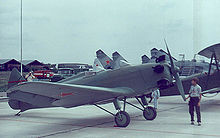Yakovlev UT-2 Video - Wings of Russia - Training and Sports Aircraft - A Road into the Sky
|
|
|
|
Yakovlev UT-2
UT-2

Role: Trainer/Fighter-trainer
National origin: USSR
Manufacturer: Yakovlev
Designed by: Aleksandr Sergeyevich Yakovlev
First flight: 1937
Number built: 7,243
Developed from: AIR-10, Ya-20
The Yakovlev UT-2 (Russian: УТ-2, NATO reporting name "Mink") was a trainer aircraft used by the Soviet Air Force from 1937 until the 1950s. It was the standard Soviet trainer during World War II.
Development
The UT-2 was designed as a trainer, more suitable for training pilots of modern and fast aircraft than the older U-2 (Po-2) biplane. The new plane was designed by Yakovlev's team at OKB-115. The next design, AIR-10, was based upon the AIR-9, but it was simpler, with two separate open cockpits, and lacking slats and flaps. It was flown on 11 July 1935. The AIR-10 won the competition with other trainer designs in 1935 and, after changes, was accepted as the standard Soviet Air Force trainer. A temporary designation for this plane became Ya-20 (Я-20). This is just because of the original AIR was the abbreviated name of Alexey Ivanovich Rykov, a communist leader executed in 1938; Yakovlev changed names of his aircraft to the politically safe Ya. The mixed construction (wood and metal) of the AIR-10 was changed to wooden only, to simplify production. A prototype used the 112 kW (150 hp) Shvetsov M-11E radial, but production aircraft used 82 kW (110 hp) M-11Gs. Serial production started in September 1937. The plane was given the designation UT-2 (uchebno-trenirovochnyi {учебно-тренировочный}, primary/advanced trainer).
The UT-2 was used also by civilian aviation. However, it soon demonstrated it was not easy to fly, with a tendency to spin. After some changes to its construction, the plane became safer and was fitted with a 93 kW (125 hp) M-11D, as the UT-2 model 1940.
To improve handling and stability, a new UT-2M (modernized) variant was developed in 1941 and put into production. The shape of wings was totally new, with a swept leading edge instead of a straight one (the wing's trailing edge was now straight), and the tailfin was larger.
In total, 7,243 UT-2 and -2Ms were produced in five factories between 1937 and 1946. Despite all improvements, the handling and flight characteristics of the UT-2 were never excellent. In the 1950s they were replaced with the Yak-18 as a primary trainer and the Yak-11 as an advanced trainer. After the war, the UT-2 and -2M were also used by countries like Poland and Hungary.
Variants

Picture - Yakovlev UT-2
AIR-10 UT-2 pre-cursor.
Ya-20 UT-2 prototype.
UT-2 (initial production)- too prone to spin.
UT-2 (1940 standard) - modified to improve spin characteristics.
SEN (UT-2N) - Air cushion landing gear tests.
UT-2M - Production from 1941, re-designed wings.
UT-2V - Bombing Trainer
Yak-5 - Single-seat fighter trainer development of UT-2
UT-2MV - Light Bomber
Operators
France
Normandie-Niemen unit
Hungary
Hungarian Air Force
Poland
Air Force of the Polish Army
Mongolia
Mongolian People's Air Force
Soviet Union
Soviet Air Force
Yugoslavia
SFR Yugoslav Air Force
1st Training Aviation Regiment (1945-1948)
104th Training Aviation Regiment (1948-1956)
Liaison Squadron of 5th Military Area (1952-1956)
Liaison Squadron of 3rd Aviation Corps (1950-1956)
Specifications (UT-2, 1940 standard)
Data from Gordon 2005, and Gunston 1995
General characteristics
Crew: 2
Length: 7.15 m (23 ft 5-1/2 in)
Wingspan: 10.2 m (33 ft 5-1/2 in)
Height: 2.99 m (9 ft 10 (tail up) in)
Wing area: 17.12 m² (184.3 ft²)
Empty weight: 628 kg (1,385 lb)
Gross weight: 940 kg (2,073 lb)
Powerplant: 1 x— Shvetsov M-11D, 93.2 kW (125 hp)
Performance
Maximum speed: 210 km/h (131 mph)
Cruising speed: 99 km/h (60 mph)
Range: 1,130 km (702 miles)
Service ceiling: 5,000 m (16,400 ft)
Rate of climb: 3.3 m/s (649 ft/min)
Armament
2 or 4 x 50 kg (110 lb) bombs (UT-2MV Light Bomber).
2 x 50 kg (110 lb) bombs + 8 x RS-82 rockets (UT-2MV Light Bomber).
Comparable aircraft
Fairchild PT-19
de Havilland Canada DHC-1 Chipmunk
Gordon, Yefim. (1989). OKB Yakovlev. London: Ian Allan. pp. 36 to 45.
Gunston, Bill (1995). The Osprey Encyclopedia of Russian Aircraft 1875-1995. London: Osprey.
Living Warbirds: The best warbirds DVD series.
Source: WikiPedia